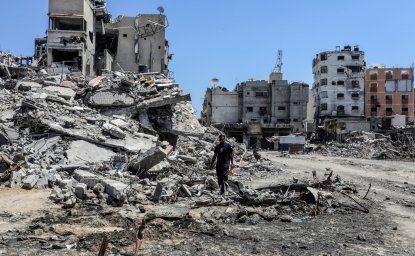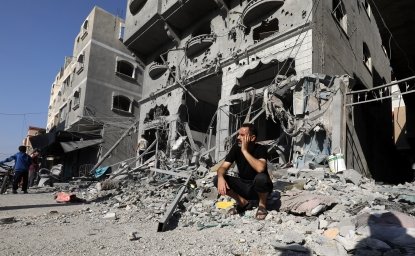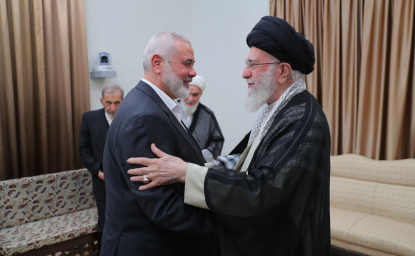The Islamic State has maintained its command structure and operational capabilities despite the loss of its leader, Abu Bakr al Baghdadi, according to a new quarterly report on Operation Inherent Resolve. U.S. Central Command said that ISIS has "remained cohesive, with an intact command and control structure, urban clandestine networks, and an insurgent presence in much of rural Syria" since Baghdadi was killed in a U.S. raid in October 2019.
But the report added that the group “did not significantly advance its insurgency” and conducted few attacks on U.S. or coalition forces between October and December 2019. ISIS had greater success targeting local government and Kurdish forces in Iraq and Syria using unsophisticated attacks.
The group was financially stable and “continues to generate revenue by extorting oil smuggling networks in northeastern Syria,” according to an assessment by the U.S. Treasury Department. “ISIS continues to have access to financial reserves in the hundreds of millions of dollars, and that it continued to rebuild fundraising networks,” the report said.
The report warned that a U.S. military withdrawal from Iraq could lead to an ISIS resurgence. On January 5, Iraq’s parliament passed a non-binding resolution calling for the expulsion of U.S. military forces. The vote followed a U.S. drone strike in Baghdad that killed Abu Mahdi al Muhandis, the deputy leader of the Popular Mobilization Forces, and Qassem Soleimani, the head of Iran’s elite Qods Force. The following are excerpts from the inspector general’s report.
STATUS OF ISIS IN IRAQ
ISIS Retains Freedom of Movement, Continues Low-level Attacks
This quarter, ISIS continued to reconstitute in the wake of the death of its leader, Abu Bakr al Baghdadi, who was killed in a U.S. raid in Syria on October 26, 2019. On October 31, ISIS announced a new leader, known as Abu Ibrahim al Hashimi al Qurayshi.38 As previously reported by the DoD OIG (Department of Defense Office of the Inspector General), the DIA assessed in November that al Baghdadi’s death would have little effect on ISIS’s ability to “maintain continuity of operations, global cohesion, and at least its current trajectory.”
In December, CJTF-OIR reported that ISIS in Iraq continued with a pattern of low-level attacks concentrated in the provinces north and west of Baghdad, but did not appear either to grow stronger or to lose its footholds in Iraq’s deserts and mountainous areas. CJTF-OIR also reported that the number of ISIS attacks was down this quarter. It said that ISIS publicly claimed 67 attacks in Iraq in the first 2 months of this quarter—roughly half as many as the 138 attacks that the group claimed in the first 2 months of the previous quarter. The DIA reported that the number of ISIS-claimed attacks may be lower than the actual number of attacks due to Iraqi government actions to limit access to the Internet during widespread street protests.
CJTF-OIR said that most ISIS-claimed attacks were opportunistic attacks on the ISF and PMF. USCENTCOM reported that attacks were largely limited to majority Sunni or mixed ethnoreligious areas.
CJTF-OIR also reported to the DoD OIG that ISIS maintained both freedom of movement and the ability to hide and transport fighters and materiel in rural areas where ISF presence is less intense and ISIS can more easily avoid detection and capture.
CJTF-OIR had previously reported to the DoD OIG that ISIS exploited “buffer zones” in mountainous areas in northern Iraq where neither the ISF nor Kurdish Peshmerga forces are in control.
This quarter, OUSD(P)/ISA reported to the DoD OIG that these zones, or “seams,” are a product of an ongoing dispute over the location of the boundary that divides areas of northern Iraq under control of the Kurdish Regional Government in Erbil, from the rest of Iraq, which is governed by Iraq’s central government in Baghdad.47 OUSD(P)/ISA said that the dispute has created a vacuum in which neither government wants to conduct operations against ISIS in areas of the seam, either due to a lack of political will or due to a fear that doing so could instigate conflict between the two governments.
This quarter, CJTF-OIR did not explicitly mention “seams,” but said that ISIS was active in areas of Diyala and Kirkuk provinces, which include areas of this seam.49 According to news reports, Kurdish leaders warned this quarter that hundreds of ISIS fighters occupy the seam and exploit the lack of security presence there.
CJTF-OIR told the DoD OIG that ISIS retains enough manpower and planning capabilities to conduct regular small-scale attacks or ambushes against the ISF, the PMF, or local civilians accused of aiding the ISF or informing on ISIS activities.51 Media reports described ISIS operatives moving at night in marshy areas of Diyala near the Iranian border, where they employ snipers or ambush ISF or PMF checkpoints. USCENTCOM reported that ISIS’s most effective operation this quarter occurred in Diyala, when ISIS attacked PMF forces, killing or wounding 23 people.
ISIS also occasionally infiltrates urban centers to conduct attacks, but has not tried to hold territory or succeeded in attacking strategic targets or damaging critical infrastructure, CJTF-OIR said.54 ISIS also has been unable to conduct major attacks in Baghdad, which USCENTCOM characterized as a “difficult operating environment for ISIS.”
CJTF-OIR reported that in terms of popular support, ISIS may receive passive support due to ideological or tribal ties, but that the vast majority of the Iraqi population, including in Sunni areas, remains hostile to ISIS. In some instances, intimidation by ISIS members had become so intense in Diyala that village residents temporarily left their homes this quarter. CJTFOIR said Sunni hostility toward ISIS also likely limited ISIS’s ability to conduct large-scale recruiting
STATUS OF ISIS IN SYRIA
USCENTCOM and DIA Provide Differing Assessments of ISIS’s Insurgent Capabilities
CJTF-OIR told the DoD OIG that the change in the level of ISIS’s resurgence in Syria since last quarter has been marginal. Despite the disruption in counter-ISIS efforts after the Turkish incursion, CJTF-OIR said that ISIS capabilities remained basically the same and that attacks had decreased this quarter.
USCENTCOM also assessed that ISIS capabilities were roughly unchanged both within and outside areas of U.S. or SDF control, and said it did not see “compelling evidence” to indicate that the redeployment of U.S. forces in northeastern Syria has resulted in any significant changes to ISIS’ operational capabilities. USCENTCOM further said that ISIS capabilities appeared unchanged in areas where U.S. forces had departed. As noted on page 35 of this report, CJTF-OIR assessed that ISIS’s inability to exploit these developments is likely due to other forces with an interest in preventing an ISIS resurgence now operating in those areas.
USCENTCOM told the DoD OIG that ISIS remained cohesive, with an intact command and control structure, clandestine networks in a number of Syrian cities, and an insurgent presence in much of rural Syria. ISIS maintained the pace, scope, and complexity of its operations in SDF-controlled areas, but did not significantly advance its insurgency, USCENTCOM said.
In contrast, as previously stated in this report, the DIA reported that ISIS claimed attacks indicate an increase since the Turkish incursion, and its activities suggest that ISIS continues to view the security environment in northeast Syria as conducive to its operations. The DIA said that ISIS claimed about 20 percent more attacks each month following the incursion this quarter.
According to open source analysis, underlying factors that enabled ISIS to rise in 2014— including local grievances, weak governance, and insurgent access to funds or resources— remain intact in Syria. For example, the Center for Strategic and International Studies, a Washington, D.C.-based think tank, reported that with the Syrian civil war nearing its ninth year, the country is carved into various controlling factions and there is weak governance, political instability, and corruption. It also found that while ISIS lost oil revenue in Syria, it has access to an estimated $50 million to $300 million to continue operations.
USCENTCOM reported to the DoD OIG that ISIS appears to have sufficient weapons, explosives, operatives, and funding to carry out its present level of operations, but assessed that it likely faces significant constraints in expanding beyond that for the next 12 to 18 months. USCENTCOM did not clarify what constraints might go away or change in 12 to 18 months.
CJTF-OIR also told the DoD OIG that the ISIS kinetic threat against Coalition forces in Syria has remained low—primarily small arms fire and IEDs.209 USCENTCOM said that although ISIS has generally struggled to attack U.S. or Coalition forces, ISIS has had more success against regime forces, Kurdish-supported civil governance elements, other violent extremist organizations, and civilians.
However, the DIA said that while ISIS capabilities remain relatively low tech, the threat remains a concern. The DIA characterized the threat as moderate.
ISIS Continues to Conduct Operations Against SDF and Regime Forces USCENTCOM
said that ISIS continued to carry out operations in Raqqah, Hasakah, and Dayr az Zawr Provinces as it did before the U.S. departure. USCENTCOM reported that, in Homs and Dayr az Zawr provinces, ISIS attacked regime forces in the desert areas with varying degrees of success. In addition, ISIS attacked “soft” targets, such as the murder of two Christian priests in Dayr az Zawr Province in November.
USCENTCOM also said that ISIS continued to conduct small-scale attacks on SDF forces and their civilian affiliates in the MERV and Hasakah Province. USCENTCOM said ISIS claimed numerous attacks in the MERV and demonstrated its capability to conduct ambushes, assassinations, and IED attacks similar in size, frequency, and complexity to those ISIS has carried out since it lost its last controlled territory in March 2019.
USCENTCOM said that in Manbij, ISIS continues to maintain a small, clandestine presence, which enables it to carry out small-scale but potentially high-impact operations. However, USCENTCOM said that ISIS did not appear to have increased the number of operatives since the U.S. withdrew from Manbij.
USCENTCOM said that ISIS did appear to have recovered some ability to coordinate complex operations in areas controlled by the Syrian regime. It said that ISIS demonstrated the ability to carry out near-simultaneous small-scale attacks against multiple targets, though these attacks have not resulted in lost terrain or significant regime casualties. USCENTCOM said it is unaware of any ISIS attacks on Russian, Iranian, or Turkish forces in Syria during the past quarter.
USCENTCOM said that after several months of relative quiet in southern Syria, ISIS fighters struck in Dara’a Province in early November, killing a regime intelligence official. ISIS claimed another attack, which killed two regime intelligence officials in the area in early December. USCENTCOM told the DoD OIG that these two attacks suggest ISIS is becoming more active in southern Syria, possibly due to regime focus on Idlib Province and the area of Turkish operations in northern Syria, and a breakdown of reconciliation between the regime and the opposition in the south.
ISIS Operations Unaffected by ISIS Leader’s Death USCENTCOM and the DIA both assessed that the October death of ISIS leader Abu Bakr al Baghdadi in a U.S. operation in Syria has not resulted in any immediate degradation to ISIS’ capabilities. USCENTCOM said ISIS likely implemented an existing succession plan upon Baghdadi’s death, and continued to operate without interruption.
Open source analysts reached similar assessments. A Center for Strategic and International Studies analysis said that al Baghdadi had long been preparing his followers to continue operations after his death and he encouraged the delegation of authority to ISIS wilayats, or provinces, abroad.
USCENTCOM told the DoD OIG that ISIS likely followed a similar succession plan to replace spokesman Abu Hasan al Muhajir—who was killed in a separate attack a day later—with current spokesman Abu Hamza al Qurayshi.
The DIA reported that ISIS’s global branches and networks pledged allegiance to al Baghdadi at the height of the “caliphate” in 2014-2015 and again during ISIS’s re-pledging campaign after his death. As of November 29, 2019, ISIS fighters from Sinai, Khorasan, Bangladesh, Pakistan, Somalia, East Asia, Central Africa, West Africa, Tunisia, Yemen, and Azerbaijan have each pledged allegiance to the new caliph.
ISIS Recruiting Limited by Sunni Resentment of ISIS Brutality CJTF-OIR reported to the
DoD OIG that ISIS maintains the capability to recruit and radicalize within Syrian IDP camps. Of the approximately 68,000 residents at the Al Hol camp, an unknown number of women retain allegiance to ISIS, according to the DoS. CJTF-OIR and DoS reported that some ISIS-affiliated women in the camp are seeking to radicalize young children and have created hisbah, or enforcement, units to assert influence over other camp occupants.
Both CJTF-OIR and USCENTCOM reported to the DoD OIG that ISIS seeks support from the Sunni population for its resurgence in Syria, but the effort would likely meet with only limited success. CJTF-OIR said that while most of the Sunni population remains opposed to ISIS rule, fear and distrust of the Syrian regime in northeastern Syria might provide recruitment possibilities for ISIS.
In its assessment, USCENTCOM said that the Syrian Sunni population still resents ISIS’s previous excesses, with public opinion polls consistently showing a low level of residual support for ISIS among Sunnis in both Syria and Iraq. USCENTCOM said that ISIS mostly relies on intimidation to gain backing, and while this often compels short-term cooperation, it does not engender long-term loyalty to ISIS from people who are not predisposed to follow its ideology.
ISIS Generates Revenue Even After Loss of Territory The Treasury reported to the DoD
OIG that in its assessment, ISIS’s revenues in Syria remain at historic lows due to its lack of territorial control over populations it can extort and lack of recurrent access to natural resources. However, the Treasury reported that ISIS continues to adapt its financial model to respond to its fundraising challenges. The DoD Office of the Deputy Assistant Secretary for Counternarcotics and Global Threats previously reported to the DoD OIG that with the loss of its territorial control in March 2019, ISIS is able to operate an insurgency on significantly less revenue.
The Treasury also reported that ISIS continues to generate revenue by extorting oil smuggling networks in northeastern Syria, though it assesses these revenues are small compared with the group’s other main sources of income: kidnapping for ransom, extortion, and looting and the use of front companies. The Treasury said that ISIS continues to have access to financial reserves in the hundreds of millions of dollars even as it works to rebuild its significantly reduced fundraising networks. ISIS primarily uses cash couriers, called hawaladars, and money services businesses to move funds within and out of Syria and Iraq.
Finally, the Treasury reported to the DoD OIG that the withdrawal of U.S. forces from areas of northeastern Syria diminished its insight into ISIS’s fundraising and cash storage activities as well as its ability to assess trends in ISIS financing in Syria.
Click here for full text of the report.

The Islamists
Learn more about Hamas and how it relates to similarly aligned organizations throughout the region. Read more

Explore More
Browse Insights & Analysis
Israel Escalates Attacks in Gaza: What’s Next?

Israel Expands Operations on Multiple Fronts: Perspectives on the Conflict


